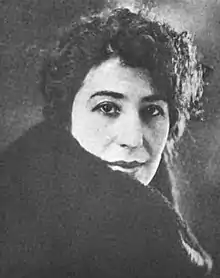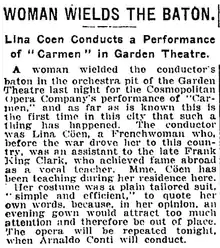Lina Coen
Lina Coen (born Caroline Marie Cohen; September 21, 1878 – April 13, 1952) was a French-American musician of Dutch descent. She won acclaim as a pianist and vocal coach and was reportedly the first woman in the United States to conduct an opera.[1]
Lina Coen | |
|---|---|
 | |
| Background information | |
| Birth name | Caroline Marie Cohen |
| Born | September 21st, 1878 Paris, France |
| Died | April 13th, 1952 Miami, Fl |
| Genres | Classical |
| Occupation(s) | pianist, vocal coach, conductor |
| Instruments | piano |
| Years active | 1896-1947 |
Life
Coen was born as Caroline Marie Cohen in Paris on September 21, 1878. Both of her parents were Jewish citizens of the Netherlands. [2]Her grandfather, Eliasar Levij Cohen, was a Dutch painter who worked in Paris while her father, Hippolijte Cohen, was a diamond merchant, based in Paris and later in Berlin.
Coen married Dutch cellist Jacques van Lier in Berlin in 1899. They had one child, Felicia Anne van Lier, born in 1901. The couple divorced in 1907 but stayed in Berlin until the outbreak of World War I. While her ex-husband and her daughter moved to Eastbourne, England, in August 1914, Coen settled in New York City in October 1914. In 1925, she obtained US citizenship under the name Lina Coen, renouncing her French and Dutch citizenship in the process.
After her father's death, Coen returned to Paris in 1921 to take her mother to New York. Her mother died at age 93 in New York in 1942 and Coen then moved to Miami to live with her daughter Felicia “Sousie” Van Lier Browne, residing with her daughter's family that included her daughter's husband Van M. Browne and their children Carolyn Browne (Dundes), Roger E. Browne and Peter V. Browne.
Career
Pianist
Having graduated from the Conservatoire de Paris, she gave her first known concert as pianist in the Kurhaus in Scheveningen in 1896.[3] At 17 years of age, she played the Hungarian Rhapsody no. 11 by Franz Liszt and the Capriccio Brillant by Felix Mendelssohn, accompanied by a Philharmonic Orchestra under the direction of Frans Mannstädt. Her future husband, Jacques van Lier, played 2nd cello that afternoon. Shortly afterwards, she moved to Berlin. Coen was solo-pianist in a concert of the Berlin Philharmoniker conducted by Josef Řebíček, performing the Piano Concerto by Robert Schumann. [4] The next year, Coen obtained a contract for a series of 45 concerts throughout Germany.[5] With her fiancé, she was part of a chamber music trio, with violinist Margarethe Baginsky. The German newspaper "Neuen Zeitschrift für Musik" found it a worrisome sign of possible times ahead, should women's rights activists get their way, that the two women overpowered the man.[6] In April 1905, Coen and Van Lier gave concerts in Leipzig and Erfurt with the German contralto Grete Hentschel. They opened with the Variations on a Rococo theme by Tchaikovsky. The critics were especially pleased with Coen's play.[7] Coen also tried her hand at composing: between 1896 and 1906, three of her compositions were published in Paris in the series "Pensée: pour piano".[8]
Soon, Coen would find the role that would define her career: accompanying opera singers on the piano. As early as 1908, she accompanied Alexander Heinemann on a tour through the Netherlands and England. Her debut in New York was in Carnegie Hall in January 1915, when she supported Olive Fremstad on the piano.[9] One year later, she was the official pianist of Leon Rothier of the Metropolitan Opera with whom she toured Canada.[10] In 1920, Coen spent nine weeks on tour with Marie Rappold, including Texas, Missouri, Oklahoma and Kansas.[11] In addition to serving as Mme. Rappold's accompanist on the piano, Coen performed as a soloist, playing compositions by Dubois (''Two Poems'') and Liszt (''Rhapsody No. 11''; ''Consolation''), music that she frequently performed, that was sometimes complemented by encore performances of ''C Sharp Minor Waltz'' by Chopin (Op. 64, No. 2) and Gluck's Gavotte by Johannes Brahms. In 1929, she accompanied Marie Rappold for concerts in the Netherlands, the birthplace of Coen's parents and grandparents. They played the Koninklijk Concertgebouw and Diligentia.[12]
Opera conductor and vocal coach

Coen was reportedly the first woman in the US known to conduct an opera, according to the New York Review (February 10, 1917) in an article entitled, “Woman Conducts Carmen Performance at Garden Theatre: Mme. Coen is First of Sex to Wield Baton in Grand Opera in America”, which quotes Coen's response to the apparently unavoidable question about her dress:
An evening gown would be out of place. Woman invades the orchestra pit not with the idea of making a sartorial display of herself, as is the case in so many instances where the box of the opera house is concerned. I want to attract attention solely by the caliber of my reading of the score of Carmen. There is not a role in the opera in which I have not coached singers who are among the foremost exponents of those particular roles, and this, I believe, gives me a greater grasp of the possibilities of the score, than perhaps some conductors display
The opera was staged by the Cosmopolitan Opera Company and featured Marta Wittkowska as Carmen, Enrico Arenson as Don Jose and Auguste Bouillez as Escamillo.[13]
Among the singers who coached with Coen were Marion Telva, Julia Culp, Jeanne Gordon, Carl Jörn, Orville Harrold, Marie Tiffany, Geneviève Vix, Claire Dux and many others.
Her career as conductor continued in 1921 when she worked with Leon M. Kramer and conducted "La Juive", at the Lexington Opera House in New York under the auspices of the Jewish American Opera Company, the first time a Grand Opera was performed in the US in Yiddish.[14] After this, Coen focused on her role as vocal coach until in 1944 when she became the musical director for her third opera, Engelbert Humperdinck´s Hansel and Gretel, presented by the University of Miami School of Music, where she had worked since 1943 as a vocal trainer.[15]
Coen died in Miami, Florida, in 1952, at age 73.
References
- "WOMAN WIELDS THE BATON.; Lina Coen Conducts a Performance of "Carmen" in Garden Theatre". timesmachine.nytimes.com. The New York Times. 1917-02-08. p. 10. Retrieved 2020-07-14.
- https://ufdc.ufl.edu/AA00010090/00772
- "Programma der Muziekuitvoeringen". Het Vaderland (in Dutch). August 24, 1896. Retrieved July 14, 2020.
- "Kunst- en Letternieuws". Het Vaderland (in Dutch). May 3, 1898. Retrieved July 15, 2020.
- "Kunst- en Letternieuws". Het Vaderland (in Dutch). May 24, 1898. Retrieved July 15, 2020.
- "Baginsky, Margarethe". Sophie Drinker Institut (in German). Retrieved July 15, 2020.
- "Neue Zeitschrift für Musik. v.101 1905 pt.1". HathiTrust. hdl:2027/iau.31858027415433. Retrieved 2020-08-06.
- Lina Coen (1906). Pensée: Pour piano (in French). A. Noel. p. 3 p.
- New York Philharmonic Leon Levy Digital Archives (January 10, 1915). "New York Philharmonic Program (ID: 1947), 1915 Jan 10". New York Philharmonic Leon Levy Digital Archives. Retrieved July 17, 2020.
- "The Musical blue book of America. 1916-17". HathiTrust. Retrieved July 16, 2020.
- The Washington Herald (December 3, 1919). "Marie Rappold on Tour". Library of Congress, Washington, D.C. 20540 USA. Retrieved 2020-07-16.
- "Marie Rappold". De Maasbode (in Dutch). April 26, 1929. Retrieved July 15, 2020.
- "The Music magazine-musical courier. c.1 v.74 1917". HathiTrust. Retrieved 2020-08-13.
- ""La Juive" in Yiddish". The American Jewish World. May 27, 1921. Retrieved July 15, 2020.
- "Miami Hurricane". merrick.library.miami.edu. May 26, 1944. Retrieved July 16, 2020.